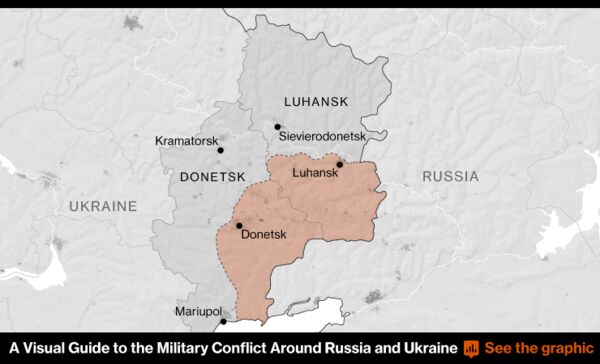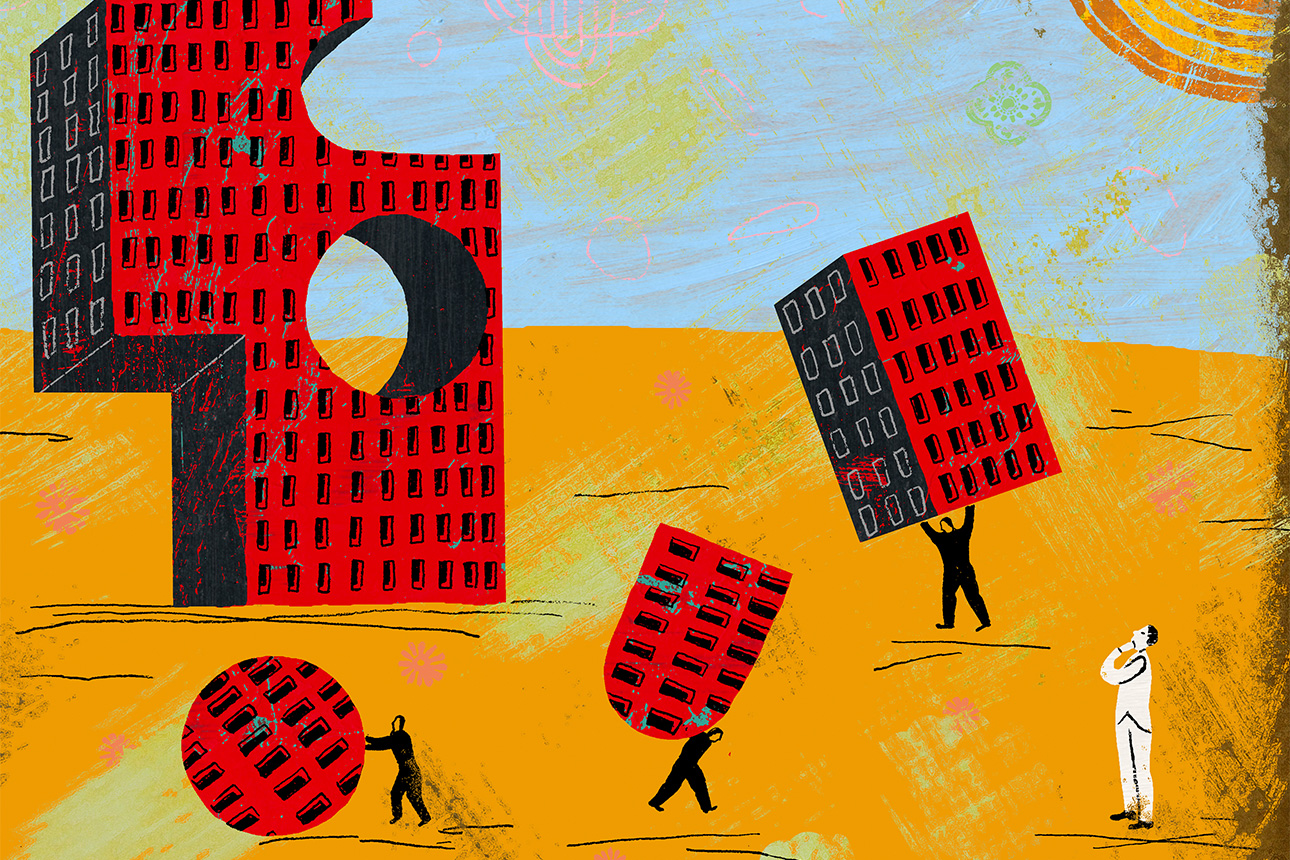Russia’s attacks on Ukraine, including shelling from Belarus across northern border, have been accompanied by separatists launching assaults in the eastern part of the country.
The government in Kyiv called it a “full-scale invasion” as it declared martial law and called for international support including harsher sanctions on Russia. Moscow confirmed it is targeting military facilities, including airfields and anti-aircraft systems.
Russia Attacks Targets Across Ukraine in ‘Dark Day’ for Europe
President Vladimir Putin said he’d ordered a special military operation to support separatists in the Donbas region in Ukraine’s east, but claimed he did not plan to occupy the country. That’s even as the U.S. had warned for weeks a broad invasion including an attack on Kyiv and other key cities was likely.
Russia was roundly condemned by Western leaders including U.S. President Joe Biden, who said more sanctions would follow. The European Union said leaders will use an emergency summit in Brussels Thursday to decide how to react.

Key Developments
All times CET:
Ukraine Says Gas Flowing Normally Despite Crisis (8:02 a.m)
State company Naftogaz says all the facilities of its gas transportation system are operating as usual and natural gas is being supplied in the required amounts. Oil transportation pipelines are also operating as normal.
Ukraine Says Russia Attacking From Belarus (7:58 a.m.)
Ukraine’s border guard service said Russian troops began attacking its units and checkpoints from across the border in Belarus in the early morning with artillery, heavy weapons and small arms.
More attacks were also coming from Crimea, the peninsula annexed by Russia in 2014, the service said. It added that Ukraine’s armed forces were returning fire.
Oil Soars Over $100 as Traders Seek Safe Bets (7:52)
Commodities markets surged, with Brent oil extending gains above $100 a barrel for the first time since 2014 while gold jumped as investors rushed for havens amid the geopolitical upheaval.
As well as oil futures, LNG spot prices in Asia extended their advance. Russia is a key supplier of energy, with Europe relying on the nation for about a quarter of its oil supplies and a third of its gas.
Aluminum rallied to a record, exceeding a 2008 peak, in a market already seeing critical shortages. Wheat prices rose to the highest since 2012 and gold hit its highest level in more than a year.
EU Plans New Sanctions Package on Russia (7:24 a.m.)
European Commission President Ursula von der Leyen “will outline a further sanctions package being finalized by the
The EU and U.S. have prepared a package that includes restrictions on some of Russia’s biggest banks, such as Sberbank PJSC and
The EU and Biden administration are also expected to introduce export controls on key technologies, such as semiconductors, aerospace, defense, and cyber surveillance technologies, plus equipment used in the energy sector. The measures are likely to target Russian oligarchs and state-owned enterprises.
Poland said it hoped NATO will deploy further troops to the eastern flank of the alliance.
Ukraine Leader in Flurry of Calls With Leaders (7:15 a.m.)
Zelenskiy said on Twitter he is “building an anti-Putin coalition” after speaking with several world leaders including Biden, German Chancellor Olaf Scholz and the European Council President Charles Michel. He called for immediate sanctions on Russia, as well as defense and financial support for Ukraine.
EU Sanctions Russians Linked to Putin But Not Many Billionaires
Scholz Laments ‘Dark Day for Europe’ (6:50 a.m.)
The German chancellor said the Russian attack is a “blatant violation of international law” that can’t be justified.
“This is a terrible day for Ukraine and a dark day for Europe,” Scholz said in an emailed statement. He was one of several leaders who held numerous talks with Putin, including traveling to Moscow, to seek a diplomatic solution. Berlin announced this week it was halting certification of the Nord Stream 2 gas pipeline from Russia to Germany.
Explainer: How Nord Stream 2 Got Stuck in Russia-Ukraine Limbo
First Central Bank Moves to Raise Rates (6:38 a.m.)
Kazakhstan raised its key interest rate to 13.5%, the highest since 2016, in the first emergency move by a central bank in a former Soviet country since Russia launched its attack on Ukraine. Such actions may be taken by other central banks in reaction to the security crisis.
What’s at Stake for Global Economy as Russia Standoff Escalates
Ukraine News Hits Stocks, Halts Moscow Exchange (6:57 a.m.)
Equities suffered heavy losses after Russia attacked targets across Ukraine, with S&P futures falling as much as 2.5% and Nasdaq contracts slumping almost 3%. Euro Stoxx futures matched that slide before the market open.
The Moscow Exchange halted trading in the ruble, stocks and futures, after the currency fell to its lowest level since 2016.
The ruble fell 3.5% to 84.1 per dollar, while Brent crude topped $100 for the first time since 2014. Gold rallied more than 1.5% to near $1,940.
Separatists in Eastern Ukraine Launch Offensive (6:56 a.m.)
Donetsk separatists launched attacks on Ukrainian positions along the entire line of contact, Interfax news service reported, citing the head of its militia, Eduard Basurin. Luhansk separatists said they were storming the city of Shchastia, which is held by Ukrainian forces, according to Interfax. There was no independent confirmation of those claims.
Putin’s move against Ukraine came after the Kremlin said the separatists had appealed to it for military help against Ukrainian forces. Kyiv has repeatedly denied it planned a military effort to try and retake breakaway areas.
Explainer: Why Donetsk and Luhansk Matter to Putin and the West
Biden Tells Zelenskiy ‘Severe Sanctions’ Coming for Russia (6:13 a.m.)
Biden spoke with Zelenskiy by telephone and told him the U.S., its allies and partners “will be imposing severe sanctions on Russia,” the American president said in a statement.
Biden said the U.S. would continue to provide support and assistance to Ukraine and is people.
The U.S. and NATO had made clear beforehand that they would not deploy troops to Ukraine in the event it was attacked, though many countries have sent defensive weapons in.
Ukraine Imposes Martial Law as Russia Attacks: President (6:15 a.m.)
“Russia has attacked our military infrastructure and our border guards,” Zelenskiy said in a video posted on his telegram channel. “In many cities explosions were heard. We are imposing martial law across the entire territory of our state.”
The Ukrainian leader urged people to stay calm and remain at home if possible, saying “we are working, the army is working.”
Russia Says Targets Ukraine Military Infrastructure: Tass (5:59 a.m.)
Russia’s Defense Ministry said it’s using “high-precision” weapons to target Ukrainian military infrastructure, Tass reported.
Russian forces are using aircraft, artillery and missiles to destroy Ukraine’s air force, military airfields and anti-aircraft systems, the ministry said, in the first official Russian confirmation that its operations extend beyond Donbas.
The Defense Ministry said it’s not targeting cities and civilians in Ukraine have “nothing to fear,” Tass reported, even as explosions were reported across the country.
Russia Attacks Checkpoints, Kyiv Under Attack: Reports (5:49 a.m.)
Russia is attacking multiple checkpoints along its border with Ukraine, Interfax news agency reported, citing people with knowledge of the matter inside Ukraine’s border guard service.
The Interior Ministry warned Kyiv was under attack from ballistic missiles and urged citizens to go to shelters. The Defense Ministry denied an earlier report by Interfax that Russian assault troops were landing in the Black Sea port cities of Odessa and Mariupol.
“Russian troops are attacking peaceful Ukrainian cities from various directions, including temporarily occupied Donbas and Crimea, as well as the northeastern region,” Ukraine’s Foreign Ministry said in a statement.
President Volodymyr Zelenskiy said he had imposed martial law.
Ukraine says Says Russia Launched ‘Full-Scale Invasion’ (5:07 a.m.)
Foreign Minister Dmytro Kuleba said in a tweet that Putin has “launched a full-scale invasion of Ukraine” and cities are under airstrikes.
“This is a war of aggression. Ukraine will defend itself and will win,” he said. Kuleba said the world can and must stop Putin, adding “the time to act is now.”
Ukraine Closes Airspace to Passenger Flights (5:17 a.m.)
Ukraine closed its airspace for passenger flights, according to a notice Thursday. Russia has also put in place flight restrictions over Ukrainian territory.
Putin Said U.S. Crossed Russia’s ‘Red Lines’ (5:01 a.m.)
Putin accused the U.S. of ignoring Russia’s demands for security guarantees and crossing its “red lines” with an expansion of NATO infrastructure east.
In his televised speech he said he aimed to demilitarize Ukraine. “Russia can’t exist with a constant threat from the territory of Ukraine,” he said.
Putin has long warned that Russia views expansion of the North Atlantic Treaty Organization in eastern Europe as a threat and he couldn’t tolerate Ukraine joining the alliance. In December, he demanded the U.S. and its allies provide legally binding security guarantees that the alliance not expand further and not put offensive weapons in Ukraine. Those demands were rejected.
NATO contends that it’s a defensive alliance and isn’t a threat to Russia.
Biden Says ‘World Will Hold Russia Accountable’ (4:42 a.m.)
Biden said in a statement that “Putin has chosen a premeditated war that will bring a catastrophic loss of life and human suffering,” adding Russia alone would be responsible for “the death and destruction this attack will bring.”
Biden said he would speak with Group of Seven counterparts Thursday and then address the American people to announce further punishments for Moscow. “The world will hold Russia accountable,” Biden said.
— With assistance by Rosalind Mathieson, Daryna Krasnolutska, Michael Winfrey, Gregory White, Alberto Nardelli, Kevin Whitelaw, Kateryna Choursina, Iain Rogers, Mariajose Vera, Jake Rudnitsky, Brendan Scott, Jon Herskovitz, Niluksi Koswanage, Vladimir Kuznetsov, and Jeff Sutherland

















